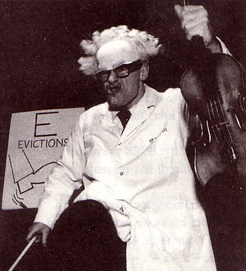Community Cultural Development
Don Adams and Arlene Goldbard’s Creative Community: The Art of Cultural Development describes the field of “community cultural development” as encompassing Community Art, as well as Engaged Research and “elements of activism and community organizing more commonly seen as part of non-arts social-change campaigns.” According to Adams and Goldbard, the term “community cultural development” captures important features of this interdisciplinary work, in that the word “community” acknowledges its participatory nature, the word “cultural” is used to “indicate the generous concept of culture (rather than, more narrowly, art) and the broad range of tools and forms in use in the field,…,” and the term “development” suggests “the dynamic nature of cultural action, with its ambitions of Conscientization … and empowerment” for participants and communities.

excerpt at: http://www.communityarts.net/readingroom/archivefiles/2001/08/community_cultu.php
“Many liberatory ideas converge in community cultural development practice, which asserts each human being’s value to both the local and the world community. The heart of the work is to give expression to the concerns and aspirations of the marginalized, stimulating social creativity and social action and advancing social inclusion. Inherent in this approach is asserting the value of diversity, fostering an appreciation both of difference and of commonality within difference. In valuing community cultural assets both material and nonmaterial, community cultural development deepens participants’ comprehension of their own strengths and agency, enriching their lives and their sense of possibility. By linking the personal and communal, community cultural development brings people into the civic arena with powerful tools for expression and communication, promoting democratic involvement in public life. Essential in an era of globalization, it creates public, noncommercial space for full, embodied deliberation of policies affecting citizens….
“At community cultural development’s core is Freire’s concept of “Conscientization”
(from the Portuguese conscientização). This describes the process by which
one moves from “magic thinking” toward “critical consciousness,” breaking
down imposed mythologies in order to reach new levels of awareness through
dialogue, thus becoming part of the process of changing the world.”
from http://www.rockfound.org/Library/CC_and_G_Chapter_1.pdf (not found November 16, 2006)
Examples of Community Cultural Development include:
Will Weigler
Will Weigler’s project for Darrington, Washington. In this small town of 1,136 people, the “Tarheel loggers” and people of the Sauk-Suiattle First Nation rarely spoke to one another. After living in Darrington for several months, Weigler wrote a play called “Common Wealth” to help these separated populations tell each other their stories.
Paula Jardine
Paula Jardine’s project for Trout Lake, Vancouver. In 1994, Jardine initiated the “Trout Lake Restoration Project” as Vancouver’s first Community Centre artist residency. The project brought together scientists, engineers, environmentalists, artists and citizens. They created art, researched environmental problems, and produced a 20-year plan for Trout Lake. She writes: “Part of defining ourselves in relation to our environment is defining ourselves as a community. For that reason there is an emphasis on Cultural Diversity when planning these events. Cultural Diversity implies not only culture of heritage, but also specific cultures of activity…. (for instance, people familiar with the culture of meetings are most likely to get involved in developing an environmental action plan in their community….)” By working with art and ceremony, she is able to engage a much wider public.
Illuminares: lanterns made of styrofoam, bamboo skewers and tissue paper, strung together behind a kayak. Four to six kayakers towing lanterns would create a slow-motion ballet on the lake, moving in choreographed patterns. From http://www.islandsinstitute.com/gallery/Jardine/Nature/slides/1a-illuminares2.html

Norman Nawrocki

Norman Nawrocki is an internationally acclaimed, Montréal-based comedian, educator, cabaret artist, musician, author, actor, and activist who works with cultural groups, trade unions and others to teach the practice of “Creative Resistance” – using art to effect radical social change. Nawrocki believes that we need to rethink the questions of “What is Public Art?” “What is Public Space?” and “Who are the Artists?” Where traditionally “public art” might be some monument created by a professional artist to occupy a patch of lawn in front of City Hall, contemporary public art might be found in the sculpted air of contested space and the imagination of people in that space. He cites as an example the midnight construction of “Parc Oxegen” in his Montreal neighbourhood. Tired of dangerous traffic and the futility of petitions, letters and representations to City Council, the neighbourhood took matters into their own hands. They dug up the asphalt, brought in truckloads of topsoil, landscaped and planted a park that blocked traffic from the residential street. This public space, activated through public initiative, can certainly be described as public art. From the first Victoria International Arts Symposium, 2006. See Nawrocki’s website at http://www.nothingness.org/music/rhythm/en/index.html
Freda Guttman
Freda Guttman has worked for many years she has worked to situate her artwork into the realm of the political. “In the 1980’s, she quit teaching art to devote herself to this goal, creating two large installations which toured Canada extensively for several years in artist-run centres: "Guatemala: The Road of War", documented the ongoing slaughter of the Mayan people of Guatemala, while "The Global Menu" focused on issues of food production and distribution - who grows it and why and at what cost to them, who consumes it. In each venue, the artist worked with local grassroots organizations, solidarity and church groups, etc. to make an extensive program of participatory activities, which involved many viewers and participants from all spheres.” http://artivistic.omweb.org/modules/wakka/Bios
Fly
The artist/activist Fly can be said to be engaged in the practice of Community Cultural Development with drawings that document the hidden stories of marginalized people, including squatters and artists, who are her friends and associates in New York City.
 |  |
http://www.speciousspecies.com/fly.htm
http://www.bway.net/~fly/peops.html
World Car Free Day

| WHAT CAN YOU DO with a 6 x 12 foot parking space? | |
| do what makes you happy | read |
| play games | make music |
| plant a garden | have a picnic |
| perform | draw portraits |
| * ... anything is possible with a little imagination! |
http://streetsareforpeople.org/actions/carfree2006.html
See also Activism as Art and Community Art